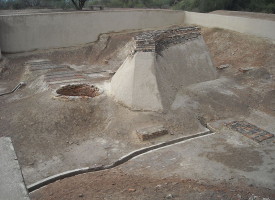You have all heard of the Great Wall of China right? The wall built to protect Ancient Chinese borders.
But have you heard of the Great Wall of Sindh or Dewar-e-Sindh? I am sure most Pakistanis haven’t. The Dewar-e-Sindh is known more commonly as the Ranikot fort. Its claim to fame is that it is even today the largest fort in the world! Yes, I did write ‘world’ and no, I am not wrong!
According to measurements, the Ranikot fort has a circumference of approximately 26km (16 miles) and is said to be the largest unexplored fort in the world. It however, is still on the list of tentative UNESCO World Heritage Sites.
Located in the Kirthar Range, the Ranikot fort is situated around 30 km southwest of Sann, in the Jamshoro District of Sindh.
The Ranikot fort is an amazing wonder. Standing magnanimously, the Ranikot fort is visible from up to five kilometers away. The fort has walls built of sandstone with 7 rectangular and 38 round bastions along the outer wall.
This fort has bewildered many over the years and is still the topic of much debate. This is because the fort basically stands in the middle of nowhere and people are still guessing as to what the original purpose of the fort could have been. What is for sure is that the fort is centuries old and has been modified through the years to accommodate the use of gunpowder.
Some say that Ranikot was built by the conquering Arabs or by a Persian noble under the Abbasid Imran Bin Musa Barmaki who was the Governor of Sindh in 836. It is however also suggested that the fort belongs to much earlier times of the Sassanian Persians and some even suggest that the fort is from the times of the Greeks.
What is left of the Ranikot fort does not have any traces of any city inside the fort and does not even provide evidence of prehistoric origins.
Although some archaeologists say that it was built in the 17th century, a detailed analysis has revealed that some of the present structure of Ranikot was reconstructed by Mir Karam Ali Khan Talpur and his brother Mir Murad Ali in 1812.
According to Isobel Shaw “The size of Ranikot defies all reasons. It stands in the middle of nowhere, defending nothing.”
No one knows for sure why the fort was built in the middle of nowhere. Some archeologists suggest that although it seems that this location did not have any importance now, it may not have been back when it was built; back in those times its location in Kohistan on the western frontiers of Sindh gave it strategic value.
Mazher Ansari presents a view that Ranikot was first constructed in the Achaemenid Dynasty of the Persian Empire (550 – 330 BC). He backs his theory by stating that this empire stretched from Turkey, where there is a similar wall near the Caspian Sea called The Great Wall of Gorgan.
Whatever the reason for its construction and its location, Ranikot is for sure a wonder and truly the “Rani” of all forts.








WONDERFUL -RANI KOT–FORT IN JAMSHORO–SINDH–PAKISTAN
THE LARGEST FORT IN THE WORLD